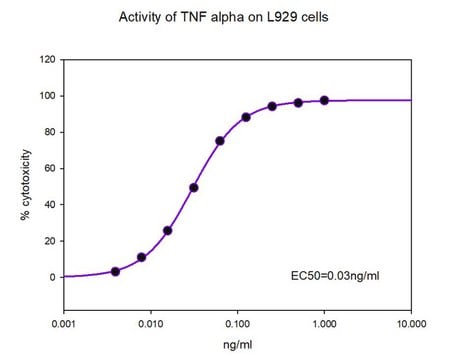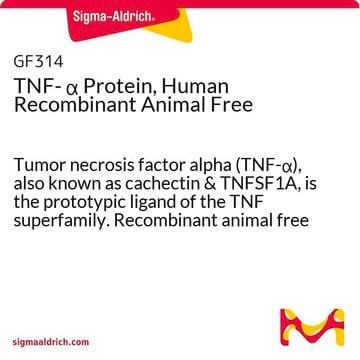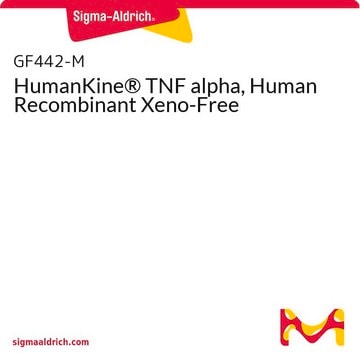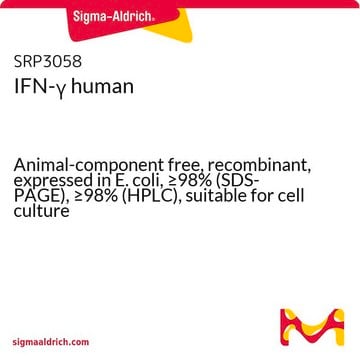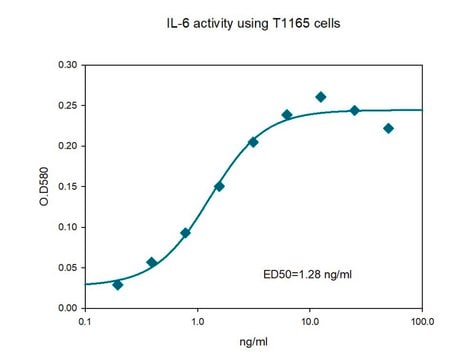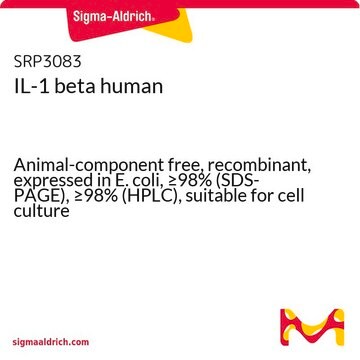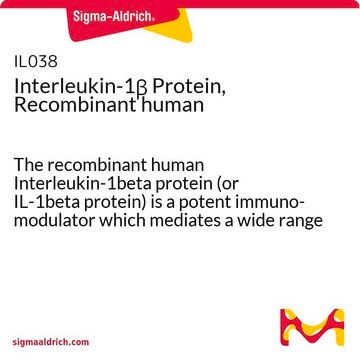Briefly centrifuge the vial before opening. Reconstitute in water to a concentration of 0.1 mg/mL. Do not vortex. This solution can be stored at 2–8 °C for up to 1 week. For extended storage, it is recommended to store in working aliquots at –20 °C.
H8916
Tumor Necrosis Factor-α human
≥95% (SDS-PAGE), recombinant, expressed in HEK 293 cells, lyophilized powder, suitable for cell culture
Sinónimos:
TNF-α
About This Item
Productos recomendados
Nombre del producto
Tumor Necrosis Factor-α human, Xeno-free, recombinant, expressed in HEK 293 cells, suitable for cell culture
biological source
human
Quality Level
recombinant
expressed in HEK 293 cells
assay
≥95% (SDS-PAGE)
form
lyophilized powder
potency
≤1.0 ng/mL ED50
quality
endotoxin tested
mol wt
17 kDa (glycosylated)
~17.4 kDa
packaging
pkg of 10 μg
storage condition
avoid repeated freeze/thaw cycles
technique(s)
cell culture | mammalian: suitable
impurities
≤1.00 EU/μg (endotoxin)
UniProt accession no.
storage temp.
−20°C
Gene Information
human ... TNF(7124)
¿Está buscando productos similares? Visita Guía de comparación de productos
General description
Application
- In induction of netting neutrophils by anti-neutrophil cytoplasmic antibody and to study its effect on platelet activation and formation of monomeric C-reactive protein.[4]
- To study the effect of TNF-α on miR-221 and fractalkine expression.[5][6]
- To induce inflammatory cell responses.[7]
- In NF-κB luciferase reporter assay.[8]
- as a permeability inducing agent for endothelial cell monolayer permeability assay[9]
- as a reactive oxygen species inducer in primary rat cardiac microvascular endothelial cells (RCMVECs)[10]
- in the activation of nuclear factor kappa B (NF-κB) in human embryonic kidney cells (HEK293), neuroblastoma SH-SY5Y cells[11] and HeLa cells[12]
- in the stimulation of the human keratinocyte cell line(HaCaT)[13] and human coronary artery endothelial cells (HCAECs)[14]
Biochem/physiol Actions
Preparation Note
Analysis Note
comparable product
Storage Class
11 - Combustible Solids
wgk_germany
WGK 2
flash_point_f
Not applicable
flash_point_c
Not applicable
Elija entre una de las versiones más recientes:
Certificados de análisis (COA)
¿No ve la versión correcta?
Si necesita una versión concreta, puede buscar un certificado específico por el número de lote.
¿Ya tiene este producto?
Encuentre la documentación para los productos que ha comprado recientemente en la Biblioteca de documentos.
Los clientes también vieron
2 Replication of Classical Swine Fever Virus
Artículos
Discover answers to your frequently asked questions about animal component-free, xenobiotic-free, and chemically defined media and reagents for cell culture.
Discover answers to your frequently asked questions about animal component-free, xenobiotic-free, and chemically defined media and reagents for cell culture.
Discover answers to your frequently asked questions about animal component-free, xenobiotic-free, and chemically defined media and reagents for cell culture.
Discover answers to your frequently asked questions about animal component-free, xenobiotic-free, and chemically defined media and reagents for cell culture.
-
How should product H8916, Tumor Necrosis Factor-alpha human be dissolved?
1 answer-
Helpful?
-
-
What is the Department of Transportation shipping information for this product?
1 answer-
Transportation information can be found in Section 14 of the product's (M)SDS.To access the shipping information for this material, use the link on the product detail page for the product.
Helpful?
-
-
What is the solution stablity of H8916, Tumor Necrosis Factor-alpha human?
1 answer-
A stock solution of H8916 can be kept at a concentration of 200-500 ug/ml (micrograms/ml) for up to 1 week at 4 °C. For long term storage, aliquot into single use size and store at -80 °C. Please avoid freeze thaw cycles as this can effect the activity.
Helpful?
-
-
What is the difference between H8916 and T6674, Tumor Necrosis Factor-α human?
1 answer-
Both products are recombinant Tumor Necrosis Factor-α human, however, they are expressed in different cell types. T6674 is expressed in Escherichia coli and H8916 is expressed in human HEK 293 cells. When recombinant human proteins are produced in human cells they are more authentic in terms of proper folding, phosphorylation, and glycosylation of the protein. Human proteins expressed in Escherichia coli do not undergo these proper post-translational modifications.
Helpful?
-
Active Filters
Nuestro equipo de científicos tiene experiencia en todas las áreas de investigación: Ciencias de la vida, Ciencia de los materiales, Síntesis química, Cromatografía, Analítica y muchas otras.
Póngase en contacto con el Servicio técnico